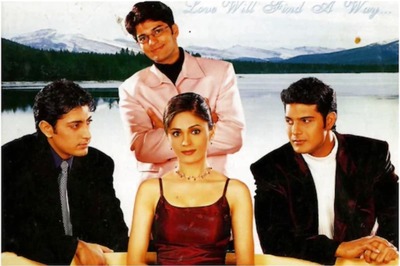How West, Middle East Gagged Freedom of Expression, and Why Women Were Excluded from Decision-Making

views
I come from a civilisation, oldest and boldest enough, that lives on while other ancient counterparts perished. Not to forget, the former remains the oldest yet blossoming. Scholars have been startled, and of all, I quote mentor of Prof Romila Thapar, AL Basham, from his book, ‘The Wonder That Was India’ — the expression looks so profound. He writes:
“The ancient civilisation of India differs from those of Egypt, Mesopotamia and Greece, in that its traditions have been preserved without a break down to the present day. Until the advent of the archaeologist, the peasant of Egypt or Iraq had no knowledge of the culture of his forefathers, and it is doubtful whether his Greek counterpart had any but the vaguest ideas about the glory of Periclean Athens. In each case there had been an almost complete break with the past. On the other hand, (…) to this day legends known to the humblest Indian recall the names of shadowy chieftains who lived nearly a thousand years before Christ, and the orthodox Brahman in his daily worship repeats hymns composed even earlier. India and China have, in fact, the oldest continuous cultural traditions in the world.”
She survived, despite the huge diversity quotient that she carried. The nuances of diversity of Bharat are so deep and it has nothing to do with rather the dumb simplification of, “all religions living together in unity,” or the notions like, “Hindu Muslim Sikh Isai, aapas mein sab bhai bhai”. Yes, we have unity in diversity and that diversity had nothing to do with the mixes of religions. Here the “unity” represents collective consciousness to abide by Ṛta. And Ṛta has been explained as the principle of natural order and the action (karma) to abide by same has been known as ‘Dharma’. As the massive diversity in geography existed, so did in observance of Dharma. We were unified by the notion to observe Ṛta and cater to diversity.
With the tradition of diversity already existing not principled on unified commandments for all, different schools of Dharmashastras too appeared. They mutually disagreed on the accounts as the terrain of region demanded but respect remained on the ground of common minimum programme whose foundation lied in observing Ṛta.
People engaged in debates, commonly known as ‘Sahstrarth‘ but nowhere did they try to infringe the Freedom of Expression of any for it was understood that every Sampraday has tried best to observe Ṛta in best of these thoughts.
With time also appeared the sects of materialist and Nastikas. Yet, despite such a radical difference in thoughts, what we saw was only a war of words and expression. We are told by Swami Vivekananda:
“There were the Chârvâkas, who preached horrible things, the most rank, undisguised materialism, such as in the nineteenth century they dare not openly preach. These Charvakas were allowed to preach from temple to temple, and city to city, that religion was all nonsense, that it was priestcraft, that the Vedas were the words and writings of fools, rogues, and demons, and that there was neither God nor an eternal soul. If there was a soul, why did it not come back after death drawn by the love of wife and child. Their idea was that if there was a soul it must still love after death, and want good things to eat and nice dress. Yet no one hurt these Charvakas.”
Though the ideas of Charvakas can certainly go way earlier than the existence of Athenian Democracy (6th Century BCE), we have primary sources to study the records of Ajita Kesakambali, a Charvaka who lived in the 6th Century BCE (based on conservative estimates). While many apologists for the western civilisation claim the Athenian Democracy must be seen as the earliest place to see the light of FoE and Democracy, we had the Hindu civilisation practicing same in Baharatvarsha millenniums before the former.
Though there is a catch here. The Athenian Democracy had all government and public roles opened for citizens, which excluded women and slaves. The paper, ‘The Position of Attic Women in Democratic Athens’, tells us an interesting case as below:
‘Before Pericles’ law that decreed citizenship to be restricted to children of both Athenian men and women, the polis did not register women as citizens or keep any form of registration for them which resulted in many court cases of witnesses having to prove that women were wives of Athenian men.’
The same source also gives us below information about women:
1. They were barred from any form of formal participation in government
2. They were left out of public discussions and speeches with orators going as far as leaving out the names of wives and daughters of citizens.
The reasons mentioned by the Athens were as below:
1. Women were more sexual, and intellectually handicapped and hence if given free range to engage in society would be more philandering.
2. Women are less intelligent than men and therefore, similarly to barbarians and slaves of the time.
In contrast, Bharat already had a system with women composing the hymns of one of the most important texts of civilization called ‘Rig Veda’. While Athenians had trouble even considering females as citizens, Ramayana observed that Sita was to replace Lord Rama on throne as initial option when the latter was instructed an exile by his father just to honour the words given to Kaikayee. And the option had come from Brahmin Kula Guru Vashistha.
Well, this essay is certainly not about the women in the ancient world, but the precedents are only given to reflect light upon the undermined fact that Ancient India had the notion of Freedom of Speech and Expression for all. This necessarily was a pertinent point which let the civilisation flourish and, traditionally, it still exists without compromising on any democratic principles.
The Red Flag
But at least in the last hundred years and necessarily in the last few days we seem to head to a slippery slope. To set things in the right perspective, I need to make readers travel way beyond merely hundred years. One of the terrains where FoE & FoS has been curtailed most is with respect to blasphemy.
What Does Blasphemy Mean & Where Lies the Origin?
As per the biblical sayings (Ps. 74:18; Isa. 52:5; Rom. 2:24; Rev. 13:1, 6; 16:9, 11, 21), it stands, “In the sense of speaking evil of God.”
The idea was very much adopted in newest offshoot which is called Islam. The verses of Quran (5:33–34, 33:57–61) & the Quran 4:140 is seen as the verse talking about witnesses of blasphemy. But the Islamic Scholars have looked to interpret these verses differently and more in line with how modern democracies should work. The Pakistani scholar Shemeem Burney Abbas explains in her book, that Qur’an mentions many examples of disbelievers ridiculing and mocking Muhammad, but never commands him to punish those who mocked him. According to her, Quran asks Muhammad to leave the punishment of blasphemy to God, and that there would be justice in the afterlife.
But we have Hadiths (Sahih al-Bukhari 4:52:270, 5:59:369, 3:45:687, 4:52:271; Sunah Abu Dawood, 38:4349, 38:4348) which clearly talks of Prophet ordering execution of people who insulted him or didn’t agree to views of Islam.
Islamic jurisprudence (fiqh) of all Islamic schools have declared different punishments for the crime of blasphemy with exceptions in few schools to repent to avoid capital punishment. Those punishments are explained in Kitab al Hudud and Taz’ir.
Often people tend to confuse Pāpa (Sanskrit) with sin or blasphemy. But this is far from the truth. I chose the most pertinent definition given by St. Augustine of Hippo. According to him, “sin is ‘a word, deed, or desire’ in opposition to the eternal law of God.”
Now refer below for Hindu view:
paropakāra puṇyāya pāpāya para-pīḍanam (3587 in the Mahā-Subhāṣita-Saṅgraha)
Puṇyā is intentionally benefiting other beings, pāpa is intentionally causing harm to others.
Hence in the morality of Hindu view nothing was like a dictate coming from God and it has always been reaction to the Ṛta. When the Abrahamic faiths were in rise in the rest of the world thereby up against the throats of each other, Bharat was engaged in nurturing the schools of sceptic thoughts. We find the remnants of Charvaka thoughts through the writings of Jayarāśi Bhaṭṭa (8th century CE), 9th century CE Jain philosopher Jinasena’s Mahapurana, Sarvadarśanasaṅ̇graha by Madhavacarya (13th century CE). The University of Nalanda stands as testimony to the fact that it not only preached the Astika ideas but also dealt with Nastika school until it was ransacked by the Bakhtiyar Khilji in 1193 CE (Minhaj-i-Siraj in Tabaqat-i Nasiri). The university had an existence of around a millennium catering to different schools of thoughts. The Ellora Caves flourished with the ideas from Astika and Nastika thoughts together from 550 to 950 CE. Dissent, disagreements and mutual respect was long part of the tradition. The elongated existence of Nastika and Astika thoughts for long millenniums in Bharat speaks aloud that there was no idea of wiping out different traditions.
Censorship in Western and Middle Eastern Worlds
In contrast, we have seen across the world apart from Bharat. Library of Antioch was burnt by Emperor Jovian in 394 CE (Christianity, Book-Burning and Censorship in Late Antiquity by Dirk Rohmann, page 240), Library of the Serapeum at Alexandria was burnt down by Theophilus of Alexandria in 392 CE after the converting the Temple of Serapis into a church (A History of Classical Scholarship From the End of the Sixth Century B.C. to the End of the Middle Ages by John Edwin Sandys, page 113), all books relating to “Ancient Sciences” at Library of al-Hakam-II at Córdoba were burnt by Al-Mansur Ibn Abi Aamir & other Islamic scholars in 976 CE (Medieval Islamic Civilization: L-Z, Index, ed. Josef W. Meri, Jere L. Bacharach, page 452), in 1029 CE, Sultan Mahmud of Ghazni burnt the Library of Rayy at Buyid Emirate as many books were deemed as Heretical. Just five years later, the Library of Avicenna at Isfahan was burnt down by Masʽud I of Ghazni (C.E. Bosworth, The Later Ghaznavids by C.E. Bosworth, page 117) so on and so forth.
Not only that, scientists and the people of science have always been censored across the ages in the Islamic and Christian worlds. The civilisation of Bharat was dealing with the ideas of what we understand as advanced sciences ages before Europe saw the light and it came to be known as Enlightenment followed with the Age of Discoveries. Their way to look at science and explorations were absolutely in synchronisation with the idea of colonisation, which had the ultimate basis to Christianise the world. With their idea of explorations came the regressive race theories. Biblical justification lied for the slavery of non-white (Genesis 9:18-27) became an important justification behind colonisation.
Yet, the scientists were facing persecution and censorship for as long as the era of Communists — Lenin and Stalin.
Al-Razi (865–925 CE), the Persian physician, philosopher and alchemist was condemned for blasphemy as he dismissed the revelation. Later, all his books were destroyed. Ibn-e-Sina (980-1037CE), another great physician, philosopher and scientist, an Uzbek, had views going completely against the Islamic doctrines. He was declared apostate by Al-Ghazali. Ibn-e-Rushd (1126-1198 CE), the Spanish philosopher and scientist, had tried to expound the Quran in Aristotelian terms and hence was found guilty of heresy. His books were burnt, and he was banished from Lucena. Omar Khayyam (1048-1131 CE), a great mathematician, astronomers and poet, was declared heretic for criticising Islam in particular. Ibn-al-Haitham (965-1040 CE), a physicist, mathematician, astronomer and an expert on optics, was ordered by Fatimid King Al-Hakim to regulate the floods of the Nile. He criticised this unreasonable madness and was placed under house arrest for the rest of his life.
Michael Servetus (1511-1553 CE), a Spanish physician credited with discovering pulmonary circulation, was arrested, tortured and burnt on the shores of Geneva at the orders of John Calvin for being declared heretic. Galileo Galilei (1564-1642 CE), an Italian astronomer and physicist, was tried and convicted in 1633 for publishing his evidence that supported the Copernican theory that the Earth revolves around the Sun. He was sentenced to house arrest, where he would remain for the rest of his life with all his texts banned.
The Marxists were also busy censoring the science, which didn’t align with their principle of ‘Dialectic Materialism’ and ‘Dialectic Determinism’. The records attest to the prolonged fight between the Marxists and the schools of Modern Physics.
Aabhas Maldahiyar is an architect and an author. The views expressed in this article are those of the author and do not represent the stand of this publication
Read all the Latest News and Breaking News here



















Comments
0 comment